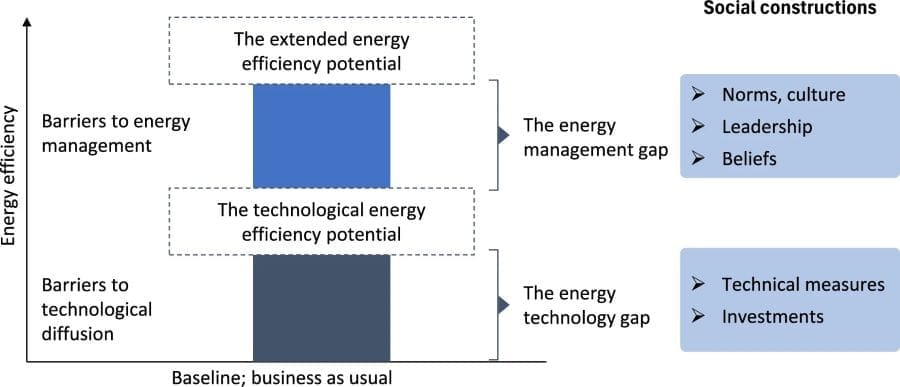Summary:
Reducing global carbon dioxide emissions from industry by at least five per cent is possible – but only if companies and policymakers move beyond a narrow focus on technology. A new study, published in Nature Communications, argues that deeper emission cuts can be achieved by adopting a broader perspective on energy efficiency, one that emphasizes the social and organizational aspects of energy management.
The research, led by scholars at Linköping University in collaboration with the University of Gävle, Lund University, Uppsala University, Stockholm Resilience Centre, and the Royal Swedish Academy of Sciences, identifies nine “social constructions” that influence how energy is managed within industry. These include knowledge sharing, interdisciplinary collaboration, and creating corporate cultures that support continuous learning and systemic thinking.
The researchers challenge the prevailing assumption that new equipment alone can deliver meaningful emission reductions. Instead, they show that combining technical improvements with organizational change and broader process thinking can unlock significantly more energy savings. If adopted at scale, these approaches could reduce industrial fossil CO2 emissions by the equivalent of ten Swedens. The authors call on policymakers to support voluntary initiatives and programs that recognize the social dimensions of energy use, and for businesses to actively integrate this thinking into their daily operations.

How to reduce global CO₂ emissions from industry
Global emissions of carbon dioxide from industry can be reduced by five per cent. But that requires companies and policy makers to take a holistic approach to energy efficiency and energy management and not solely focus on technological development. This is the conclusion of researchers, including from Linköping University, in the journal Nature Communications.
“We have a far too narrow view of energy efficiency. Many people think that investments in new energy-efficient equipment are enough. But then you can’t fulfil the full potential of energy efficiency,” says Patrik Thollander, Professor in Energy Systems at Linköping University.

Together with colleagues at the University of Gävle, Stockholm Resilience Centre, Lund University, Uppsala University and the Royal Swedish Academy of Sciences, he has analysed what would be required for industries to be able to minimise their energy use.
The concept of energy efficiency emerged as a necessity in the oil crisis of the early 1970s. Then, energy prices skyrocketed, and energy efficiency measures were taken to reduce the cost to companies. Now, with an accelerating climate crisis, this is necessary to reduce emissions of fossil carbon dioxide.
Both the International Energy Agency (IEA) and the European Commission think that energy efficiency is the first measure to take and a cornerstone for achieving climate neutrality. However, according to the researchers, there is considerable potential in energy efficiency that remains untapped.
Energy efficiency has long been associated primarily with technological innovations, but Patrik Thollander and his colleagues think that more than that is required. To substantially reduce carbon dioxide emissions, the way organisations work and think about energy use needs to change.
The researchers highlight the importance of system-wide processes, increased knowledge dissemination and a corporate culture that promotes change. They call these factors social constructions, and they have identified nine that would help companies design their energy efficiency and energy management processes in a better way.
“We estimate that this could lead to a 5% reduction in CO2 emissions from industry globally. And that’s a rather conservative estimate, it could even be more,” says Thollander.
According to the IEA, in 2022 the world’s industries emitted 9.2 gigatonnes of carbon dioxide. A five per cent reduction corresponds to the carbon dioxide emissions of ten countries the size of Sweden.
Patrik Thollander thinks that one of the most important factors for success is collaboration between people with different experiences and backgrounds within companies.
“As an engineer, I think of technology solutions first. But potential can be developed if you have worked with whole systems and in collaboration with other expertise that has a different mindset. We need to work in an interdisciplinary way to succeed,” says Thollander.
He thinks companies need to work actively to build interdisciplinary collaborations between engineering, social science and behavioural science disciplines. Therefore, the researchers urge industrial companies to create a corporate culture that supports knowledge sharing and continuous learning. The challenge to policymakers is to design different types of programmes that stress the social dimensions of energy efficiency.
Journal Reference:
Thollander, P., Andrei, M., Jalo, N. et al., ‘Advances in the social construction of energy management and energy efficiency in industry’, Nature Communications 16, 4075 (2025). DOI: 10.1038/s41467-025-59284-2
Article Source:
Press Release/Material by Linköping University
Featured image credit: Matthias Heyde | Unsplash




